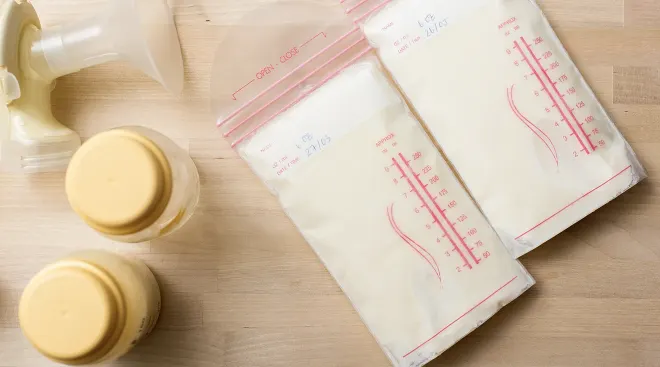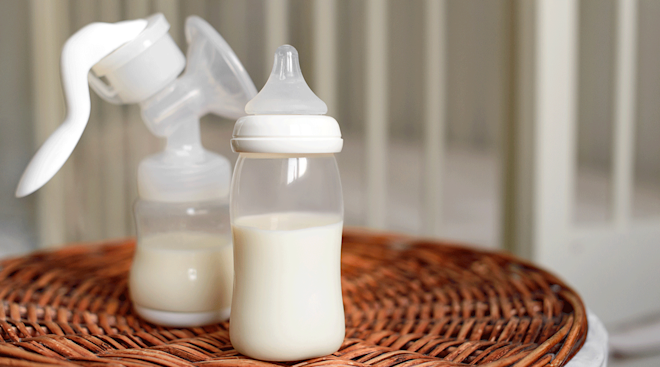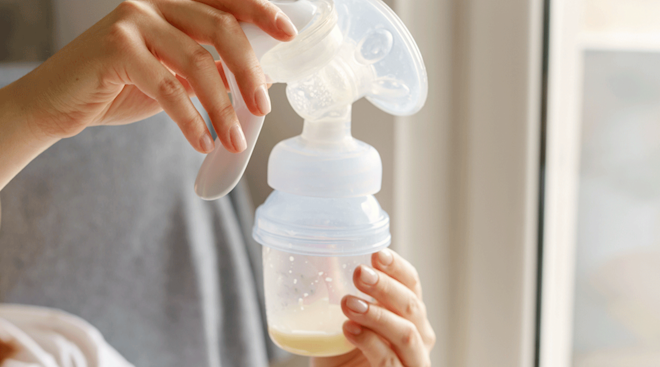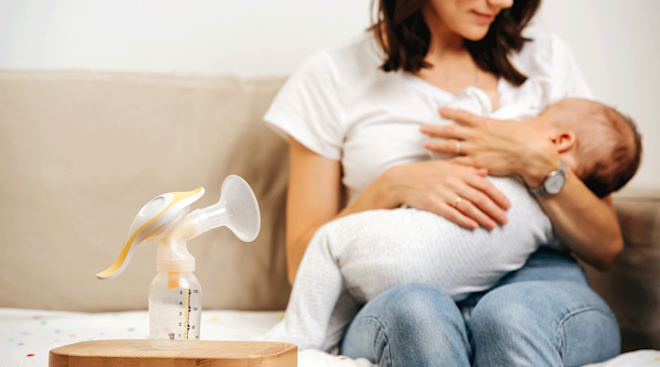Breast Engorgement: What It Is and How to Find Relief
Here’s yet another thing you perhaps weren’t prepared for post-childbirth: huge, heavy, hard breasts that are tender to the touch and feel like they’re about to explode. So what’s the deal? You’re likely experiencing breast engorgement. While plenty of breastfeeding women experience engorged breasts, if left untreated it can lead to issues like cracked nipples, clogged milk ducts and mastitis—not fun. Read on to learn how to tell if your breasts are engorged and how to find fast relief.
Breast engorgement is when your breasts overfill with milk, and as a result become swollen, hard and painful. Here’s how it works: Lobules in your breast create and store milk so when baby is hungry, your body has a ready-to-go supply (plus whatever it needs to make more milk on demand). If your breasts aren’t fully or frequently emptied, milk can collect in the lobules, causing your breasts to swell or become firm.
Engorgement typically takes place a few days after birth, when your breasts switch from producing colostrum to mature milk, explains Stephanie Heintzeler, a doula and International Board Certified Lactation Consultant (IBCLC) at The New York Doula “Usually within two days the breast will become softer again and full only right before a feed.”
While engorged breasts may be uncomfortable, they can be a sign your body is working properly. “Many mothers think engorgement is an infection, but luckily that’s rarely the case,” Heintzeler says. “As long as there’s no fever involved and the breast gets emptied regularly, it’s a normal process that should subside within a couple days.”
You can also experience breast engorgement if there’s a buildup of other fluids, not just milk. “Engorgement can happen when lymphatic fluid is trying to leave the breast through the area around your armpit at the same time that your body is trying to make milk to leave through the nipple,” explains Victoria Facelli, IBCLC, a lactation consultant at Emerald Doulas in Durham, North Carolina. “One fluid is trying to go one way and the other is going the opposite way, leading to a traffic jam.”
What causes breast engorgement?
While breast engorgement can develop at any point while lactating, it’s especially common when your milk first comes in, usually two to six days after baby is born. After all, blood and fluid is rushing to your breasts to prepare them for making milk, not to mention the increase in milk itself. Plus, your body is still figuring out how much milk baby needs and may produce more than necessary. Some women may notice a little fullness during this time, while for others the engorgement can be more significant.
Another possible cause of early breast engorgement: Dehydration and IV fluids that were administered during delivery can lead to fluid retention, Facelli says, making it harder for the lymphatic system to work efficiently.
As baby gets older, other possible causes come into play. “If the breasts are getting engorged once breastfeeding has been established, it’s usually because the breast hasn’t been emptied for four or more hours or due to stress or lack of sleep,” Heintzeler says. You may also experience breast engorgement if your child has trouble breastfeeding or suddenly nurses less, either due to illness or the introduction of solid foods; or if you abruptly stop breastfeeding.
Breast engorgement is one of those “you’ll know it when you feel it” phenomenon, but there are some telltale signs to look out for. Common breast engorgement symptoms include:
• Swollen, tender breasts. It’s normal for your breasts to grow a few cup sizes post-delivery, but if they seem larger than normal, or don’t return to your “new normal” size after feeding or pumping, you may be engorged.
• Hard breasts. If your breasts are firm and feel like they might eject milk at the lightest touch (or without being touched at all), breast engorgement may be the culprit.
• Flattened nipples. A buildup of milk in the breast can cause the nipples to flatten out and the areola to become hard, making it difficult for baby to latch properly.
• A red or hot area on your breast. This spot may feel like a bruise. “If you see this, it may be a sign of infection, and it’s important to loop in your ob-gyn ASAP,” Facelli says.
How long does breast engorgement last?
You should feel relief as soon as your breasts are emptied of milk. During those first few days while experiencing engorgement post-birth, your breasts should feel more comfortable immediately after a feeding, and the swelling should subside within a couple days. If you’re feeling engorged once breastfeeding has been established, “lots of breastfeeding and resting in bed usually resolves engorgement within 24 hours,” Heintzeler says. Trying a few different relief options—with feeding baby being the first line of defense—can help your body feel better.
You may think pumping will relieve breast engorgement, and it will—in the short term. But in the long term, pumping only encourages your body to produce more milk, exacerbating the issue. “During the first few days, your body is figuring out how much milk is needed for baby,” Heintzeler says. “If you pump, then you’re telling your body to make more milk.” That’s not ideal if all you want to do is relieve pressure.
Instead, put baby to the breast as often as possible. She should nurse until your breast feels empty; if it doesn’t, it could mean she’s not transferring milk effectively. Flag the concern with your pediatrician or a lactation consultant who can check baby’s latch.
Here, some easy at-home tactics for how to relieve engorged breasts:
• Wake baby to feed. “If you’re feeling uncomfortable, breastfeed as often as every hour or two, and don’t be afraid to wake baby to eat—or to put him to the breast when he’s drowsy or in a light sleep,” says Nancy Mohrbacher, IBCLC, FILCA, a lactation consultant and coauthor of The Breastfeeding Answer Book.
• Apply a warm, moist compress. Warming your breasts right before a feeding can help soften your breasts and encourage letdown. But apply the compress for just a few minutes—using heat for too long can increase swelling and inflammation.
• Massage your breasts. Gently massaging your breasts can bring down the swelling and help it drain, Facelli says. Using the pads of your fingertips, circle your breasts toward the nipple and push in toward the wall of your chest.
• Use a cold compress. If you’re still feeling uncomfortable after a nursing session, try an ice compress on your breasts in between feedings to reduce inflammation, Facelli says. Placing cold, clean cabbage leaves on your breasts can also help minimize engorgement. Note, though, that studies have found that cabbage leaves may be less effective than hot or cold compresses. Some say the overuse of cabbage leaves can lead to a diminished milk supply, so discontinue after the swelling goes down.
• Pop a painkiller. Tylenol or ibuprofen can relieve the pain associated with breast engorgement, but check with your doctor before taking any medication, Mohrbacher says.
• Hand-express milk. Heintzeler recommends using your hands or a manual pump to express a bit of milk—this process is more gentle than using an electric pump, and can soften your breasts just enough for baby to latch on with ease. A lactation consultant can show you how to hand-express, or you can follow this guide.
There’s no getting around at least some mild engorgement as your milk comes in post-birth, but don’t panic: It’s a sign your body is working as it should be. That said, these tips can help prevent breast engorgement from occuring later on in your nursing journey.
• Nurse early and often. Breastfeeding baby as soon as possible after birth, and then at least every two to three hours after that, will help keep your breasts from overfilling.
• Don’t limit baby’s time at the breast. Resist the urge to get your newborn on a breastfeeding schedule: Feed baby on cue, whenever she’s hungry. Let her fully empty the first breast before switching her to the other.
• Make sure baby has a good latch. If baby isn’t able to effectively empty your breast, it can lead to a buildup of milk. Speaking with a lactation consultant—even while you’re still in the hospital after giving birth—can help you determine whether baby has a good latch and troubleshoot any breastfeeding problems from the start.
• Have a plan if you’re away from baby. If you’re separated from baby for more than a few hours, you may find yourself dealing with engorged breasts. Even if you’ve already pumped milk for baby to eat while you’re gone, make sure to pump while you’re away to relieve engorgement and keep your body on the same schedule it’s used to with baby. A handheld pump can be easier and less bulky to carry, and can come in handy if you’re in a place without a place to pump.
• Skip the electric pump. Sometimes, a very engorged breast can make it hard for your infant to latch. If that’s the case, hand express some milk, or use a handheld pump, only until the feeling of extreme fullness has passed. If you can, wait a few weeks before you try using˜ an electric pump, which can help ensure your supply is regulated.
• Drink plenty of water. Water keep the lymphatic system working as efficiently as possible, helping to minimize the “traffic jams” that can occur in your breasts during engorgement.
Updated January 2018
Please note: The Bump and the materials and information it contains are not intended to, and do not constitute, medical or other health advice or diagnosis and should not be used as such. You should always consult with a qualified physician or health professional about your specific circumstances.
Plus, more from The Bump:
Navigate forward to interact with the calendar and select a date. Press the question mark key to get the keyboard shortcuts for changing dates.




















































